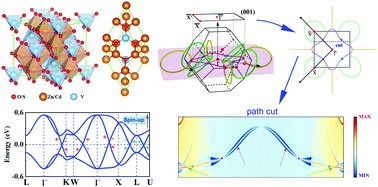Computational discovery of spin-polarized semimetals in spinel materials†
Abstract
Materials with spin-polarized electronic states have attracted a huge amount of interest due to their potential applications in spintronics. Based on first-principles calculations, we study the electronic characteristics of a series of AB2X4 chalcogenide spinel structures and propose two promising candidates, VZn2O4 and VCd2S4, that are spin-polarized semimetal materials. Both of them have ferromagnetic ground states. Their bands near the Fermi level are completely spin-polarized and form two types of nodal rings in the spin-up channel, and the large gaps in the spin-down channel prevent the spin-flip. Further symmetry analysis reveals that the nodal rings are protected by the glide mirror or mirror symmetries. Significantly, these nodal rings connect with each other and form a nodal chain structure, which can be well described using a simple four-band tight-binding (TB) model. The two ternary chalcogenide spinel materials with a fully spin-polarized nodal chain can serve as a prominent platform in the future applications of spintronics.



 Please wait while we load your content...
Please wait while we load your content...